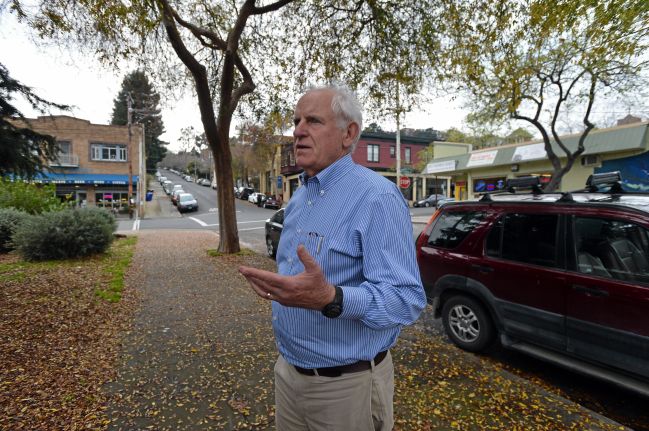Marin Clean Energy is adding new members, but proposed bill could stunt growth
By Richard Halstead
rhalstead@marinij.com @HalsteadRichard on Twitter
Posted: 07/20/2014 03:45:21 PM PDT3 Comments

Richmond City Councilmember Tom Butt, pictured in 2013, said the main reason his city joined Marin Clean Energy was not cost savings, but to give residents an opportunity to buy greener power. (Kristopher Skinner/Bay Area News Group)
Related Stories
Marin Clean Energy is continuing to grow, despite proposed state legislation that could place limits on that growth.
Marin Clean Energy, the first successful attempt in California to launch a new, public model for providing electricity to residents, recently added its second member located outside of Marin County, the county of Napa. The local energy authority's board has also granted its approval to add the city of San Pablo, whose council is expected to vote in August on whether to make the move.
The cities of Benicia and El Cerrito also have asked MCE to consider the feasibility of adding them as members. Even cities as large as Santa Barbara and San Francisco have flirted with the idea of joining MCE.
The addition of the county of Napa could add as many as 16,000 new electricity customers to MCE's roster, and the city of San Pablo could supply an additional 10,000. Currently, Marin Clean Energy consists of the county of Marin, all 11 of Marin's municipalities and the city of Richmond. MCE serves as the retail electricity provider for some 125,000 customers.
MCE was founded to jump-start the use of renewable energy sources by stimulating demand; it offers customers the opportunity to buy electricity that is supplied by 50 to 100 percent renewable sources. Renewable sources account for 20 percent of Pacific Gas & Electric Co.'s energy.
Before accepting new members, MCE conducts analysis to verify that the addition of that entity will not result in higher rates for existing authority customers. MCE's managers have estimated that the addition of Napa County will result in a 3 percent rate reduction for authority customers, and the addition of San Pablo would reduce rates by another percentage point.
Dawn Weisz, MCE's executive officer, estimates that customers will pay $5 million less in rates this year than they would have had they remained customers of investor-owned PG&E.
The city of Richmond, which joined MCE last year, will save about $60,000 and Richmond's West Contra Costa Unified School District expects to save $66,000. But Richmond City Councilman Tom Butt said cost savings wasn't the reason his city decided to join.
"The overriding reason was to offer residents and businesses the opportunity to buy greener energy and to contribute to a reduction in greenhouse gases," Butt said.
Weisz said, "Our mission statement is to reduce greenhouse gas emissions. This is a global issue. If we just stayed in one place, we would have a limited effect on greenhouse gas emissions. That is why we spend time trying to help other community choice aggregation programs to get started around the state."
MCE estimates that including Napa County in its authority will increase the amount of renewable energy being used in California's energy market by approximately 72,000 megawatt hours per year while reducing greenhouse gas emissions by an estimated 21 million pounds of carbon dioxide per year.
Brad Wagenknecht, a member of the Napa County Board of Supervisors, said, "The most attractive thing to us is being able to produce our own electricity."
Wagenknecht said Napa has plenty of suitable locations for the installation of solar panels, but he said currently it is difficult to sell excess electricity generated by solar panels to PG&E.
"With PG&E, it is very complicated. You have to go through all sorts of permutations trying to sell back the electricity," Wagenknecht said.
Wagenknecht said sparsely populated jurisdictions such as Napa County lack the resources to start their own energy authorities under the state's community choice aggregation law.
"With our limited administrative capacity, it would take us years," Wagenknecht said.
Nevertheless, a bill scheduled to be considered by the state Senate's Appropriations Committee on Aug. 4 would limit the size of a CCA joint powers agency to no more than three contiguous counties. AB 2145, sponsored by Assemblyman Steven Bradford, D-Gardena, a former public relations executive for Southern California Edison, started out as an attempt to radically alter the rules governing the formation of CCA programs.
AB 2145 would have made it virtually impossible for such efforts to raise the money needed to launch. Bradford, however, agreed to drop a provision requiring new customers to opt in to newly formed CCA programs when it appeared likely the bill lacked the votes necessary to get out of the state Senate's Energy Committee in June.
Hunter Stern, a business representative for the International Brotherhood of Electric Workers Local 1245, which supports AB 2145, said it makes sense to limit CCA programs' geographic scope.
"AB 2145 was intended to make sure that Community Choice remains community oriented and not create another utility," Stern said. "There is no connection between Marin County and the city of Richmond, other than a bridge."
|

